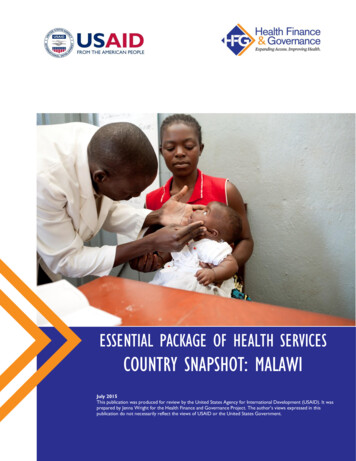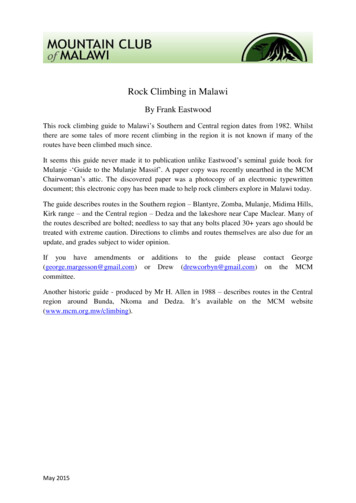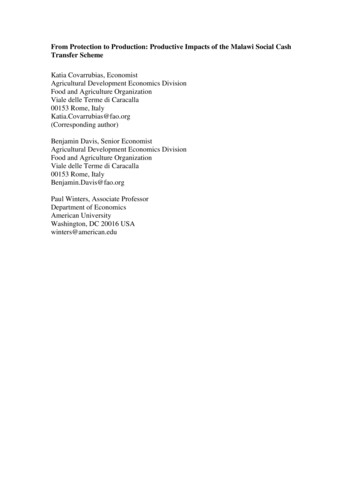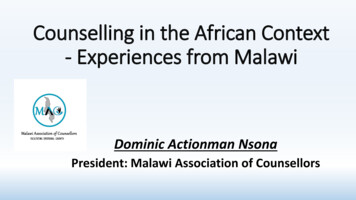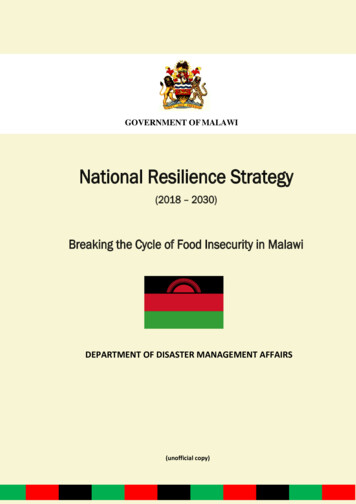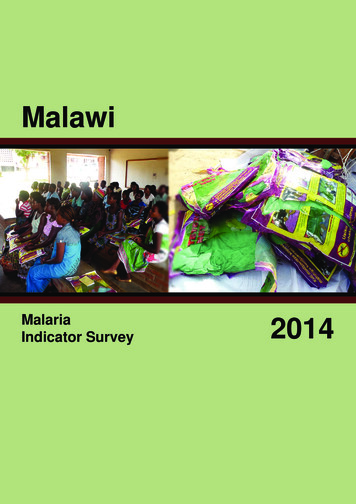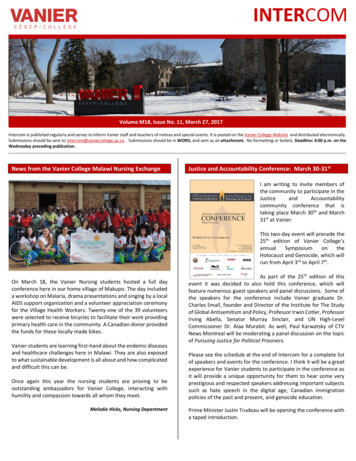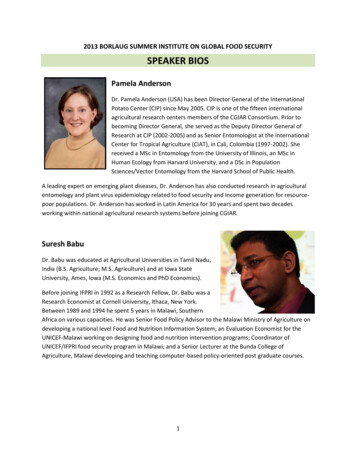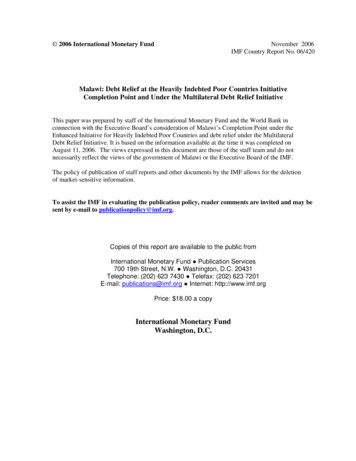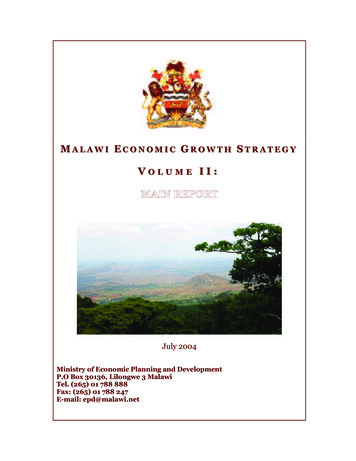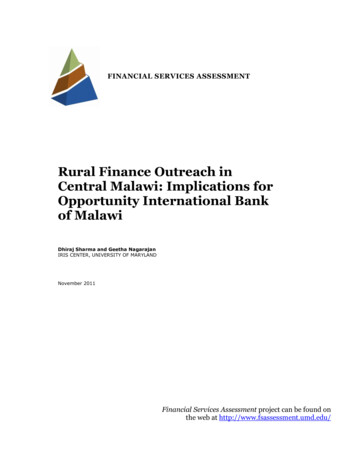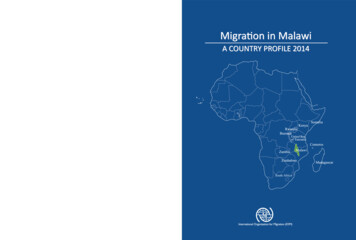
Transcription
Migration in MalawiA COUNTRY PROFILE 2014Migration in MalawiA COUNTRY PROFILE 2014South AfricaInternational Organization for Migration (IOM) - MalawiOff Presidential Highway, Area 14Plot number 156, Lilongwe, MalawiWebsite: http://www.iom.int
The opinions expressed in the report are those of the authors and do not necessarilyreflect the views of the International Organization for Migration (IOM). The designationsemployed and the presentation of material throughout the report do not imply expressionof any opinion whatsoever on the part of IOM concerning legal status of any country,territory, city or area, or of its authorities, or concerning its frontiers or boundariesIOM is committed to the principle that humane and orderly migration benefits migrantsand society. As an intergovernmental organization, IOM acts with its partners in theinternational community to: assist in the meeting of operational challenges of migration;advance understanding of migration issues; encourage social and economic developmentthrough migration; and uphold the human dignity and well-being of migrants.This publication was made possible through the financial support provided by the IOMDevelopment Fund (IDF). The opinions expressed herein are those of the author and donot necessarily reflect the views of the IDF.Publisher: International Organization for Migration17 route des MorillonsP.O. Box 171211 Geneva 19SwitzerlandTel: 41 22 717 9111Fax: 41 22 798 6150E-mail: hq@iom.intWebsite: www.iom.int 2015 International Organization for Migration (IOM)All rights reserved. No part of this publication may be reproduced, stored in a retrievalsystem, or transmitted in any form or by any means, electronic, mechanical, photocopying,recording, or otherwise without the prior written permission of the publisher.58 15
Migration in MalawiA COUNTRY PROFILE 2014Prepared byDavid Ndegwa
FOREWORDThe Government of the Republic of Malawi and the InternationalOrganization for Migration (IOM) are pleased to release the country’s firstMigration Profile, jointly prepared under the overall guidance of the TechnicalWorking Group established for the purpose and chaired by the Ministry of HomeAffairs and Internal Security.Migration Profiles were initially proposed by the European Commission inthe Communication on Migration and Development in 2005, and conceived asa concise statistical report, prepared according to a common framework, whichcould make it easier to understand “at a glance” the migration situation in aparticular country. Since the first Migration Profiles in 2006, IOM has preparedMigration Profiles for more than 40 countries around the world. Over time,migration profiles have undergone considerable transformation in format,content and objectives – from being a means of bringing together data froma wide range of sources, to a more elaborate process involving consultationwith many different actors in an effort to help identify and develop strategiesto address data gaps and produce the evidence required to inform policy. Inshort, a Migration Profile is a country-owned tool, prepared in consultationwith a broad range of stakeholders, which can be used to enhance policycoherence, evidence-based policymaking and the mainstreaming of migrationinto development plans.The decision to produce a National Migration Profile for Malawi isprimarily driven by the Government’s desire to develop a comprehensivenational migration policy that would address the complex migration dynamicsMalawi faces as a country of origin, transit and destination. Following Malawi’smembership to IOM in 2013, the compilation of a reliable evidence base thatwould inform such a policy emerged as a priority. Although data on migrationwas captured across a wide range of ministries, departments and agencies, itremained scattered and of limited use for policymaking purposes. This led to thedevelopment and subsequent implementation of IOM’s first ever project in thecountry supported by the IOM Development Fund, under which this MigrationProfile was produced. The product brings together existing information fromdifferent sources in a structured manner and provides a comprehensiveoverview of key international migration and socioeconomic development trendsin Malawi. It also identifies data gaps and potential strategies to improve datacollection for policy and planning purposes.Migration in Malawi: A Country Profile 2014iii
In order to remain an effective information tool for policymaking,Migration Profiles must be updated regularly and used for policy development.The sustainability of the governmental mechanism established to preparethe Migration Profile is crucial. In this regard, we are pleased to note that aTechnical Working Group, composed of various stakeholders, was set up at thebeginning and remained fully engaged throughout the process. This not onlykeeps the Migration Profile a truly effective policymaking tool but also ensuressustainability. Complementary activities were also undertaken with the aim ofpreserving national capacity to regularly update the Migration Profile for use bypolicymakers and practitioners.We would like to thank the expert, David Ndegwa, for drafting the report;the IOM Regional Office for Southern Africa for coordinating the project underwhich the Migration Profile was produced; the IOM Research Unit for reviewingand editing the Migration Profile; the IOM Development Fund for its generousfinancial support and last, but by no means least, members of the TechnicalWorking Group who provided valuable input to the report at different stages.Bernardo MarianoHon. Minister Atupele Muluzi (MP)Regional Director MinisterInternational Organization for MigrationMinistry of Home AffairsRegional Office for Southern Africaand Internal SecurityRepublic of MalawiivMigration in Malawi: A Country Profile 2014
AcknowledgementsThis publication was made possible by the very cordial cooperation of thevarious ministries of the Government of Malawi led by the Ministry of HomeAffairs and Internal Security. Many thanks go to the two eminent permanentsecretaries in the Ministry of Home Affairs who ensured that this work got offthe ground – Mr Zangazanga Chikhosi and his successor, Mr Bestone Chisamile.The author would like to express his sincere gratitude to the hard workand contribution of Mr Mathews Phiri, the short-term national consultant forthe project who prepared the data for analysis from various sources.True to Malawi’s “warm heart of Africa” reputation and her people, warmwelcome was extended to the IOM as an organization and to the internationalconsultant. Special thanks go to Dr Hudson Mankhwala, Chief ImmigrationOfficer of Malawi, who made sure that an office accommodation was ready forIOM and humbly provided prompt assistance on data and information. The verysupportive roles of Ms Patience Mamba and Mr Davis Sado at the Ministry ofHome Affairs were instrumental in ensuring that the Technical Working Group(TWG) was constituted and functional. Mr Charles Mphande, the Ministry ofHome Affairs Undersecretary, later provided very able and passionate steer tothe TWG. The author would also like to express gratitude to Mr George Kuchio,the United Nations High Commissioner for Refugees’ Country Representativefor Malawi, who provided enormous support and cooperation during the entireprocess.Many IOM colleagues at the regional office in Pretoria, headed by MrBernardo Mariano, also ensured that the project was successful. The team thatsupported the Malawi Migration Profile Process, led by Mr Yitna Getachew,also included Ms Sikhulile Dhlamini, Ms Amy Truong and Mr Feridoon Barraghi.Although others are not named here, their contribution as IOM staff ensured asuccessful migration profile process for which they deserve gratitude.Finally, inputs from colleagues in IOM Geneva’s Research Division providedvaluable reviews and inputs to the various drafts of this report. Many thanks goto Ms Tara Brian, Mr Denis Kierans and others who have read the work andprovided inputs.Migration in Malawi: A Country Profile 2014v
Technical Working Group MembersRepresentativeDavis SadoCharles A. MphandeAubrey KabisalaJoseph MpangoPaul GondweAnne NamagonyaDina GumuliraMedson MakwembaPatience MambaKelvin SentalaSylvester ChapoteraDaud Cassam CassimGeorge MandereMuopeni NgwaloHilda KausiwaDepartmentMinistry of Home Affairs and Internal SecurityMinistry of Home Affairs and Internal SecurityMinistry of Foreign Affairs and InternationalCooperationMinistry of Foreign Affairs and InternationalCooperationMinistry of Labour and Manpower DevelopmentMinistry of Gender, Children, Disability and SocialWelfareMinistry of Gender, Children, Disability and SocialWelfareNational Statistical OfficeMinistry of Home Affairs and Internal SecurityUNHCRUNHCRDepartment of ImmigrationUniversity of Malawi Department of PopulationStudiesReserve Bank of MalawiDepartment of Refugees, Ministry of Home Affairsand Internal SecurityMigration in Malawi: A Country Profile 2014vii
ContentsForeword.iiiAcknowledgements.vTechnical Working Group members. viiAcronyms. xiiiMap of Malawi and key statistics. xvExecutive summary.1Introduction and structure of the report.5Part A: Brief historical overview of migration trends for Malawi.7Part B. Current migration patterns within the development context .9B.1 Development, demographic change and net migration. 9B.1.1 Millennium Development Goals. 9B.1.2 Demographic changes. 13B.1.3 Net migration. 21B.1.4 Economic environment. 23B.1.5 Labour market. 28B.1.6 Human capital. 30Part C: Analysis of the migration situation in the country.33C.1 Immigrants. 33C.1.1 Total number of immigrants. 33C.1.2 Types of immigrants. 40C.1.3 Irregular immigrants. 46C.2 Emigrants. 48C.2.1 Total number of emigrants. 48C.2.2 Types of emigrants. 51C.2.3 Irregular emigrants. 54C.3 Diasporas. 55C.4 Remittances. 56Part D: Factors of migration.59D.1 Main characteristics of current migration trends. 59D.2 Identifying the key drivers of migration and possible future trends. 59Migration in Malawi: A Country Profile 2014ix
Part E: Migration management legal and policy environment.61E.1 Overview of the national institutional and policyframework governing migration. 61E.1.1 Overview of recent migration policy developments. 61E.1.2 Overview of domestic legislation . 61E.1.3 Description of institutional actors involvedin migration management. 63E.2 Analysis of migration policy coherence. 67E.3 Regional and international cooperation. 68E.3.1 Bilateral labour agreements. 69E.4 Overall assessment of the migration policy context. 70Part F: Evaluating the consequences of migrationand migration policy on development.71F.1 Impacts of migration on the socioeconomic development of the country. 71F.2 Impact of migration policies on the development of the country. 71Part G: Conclusions and recommendations.73G.1 Main findings on current migration trends. 73G.2 Recommendations on improving migration statistics. 74G.3 Recommendations regarding migration management. 77References.79Annex: Statistics.83list of tablesTable 1.Table 2.Table 3.Table 4.Table 5.Table 6.Table 7.Table 8.Table 9.Table 10.Table 11.Table 12.Table 13.Table 14.xMalawian migrant workers contracted to South Africanchamber of mines, 1984–1991. 8Trends in poverty level (1998, 2004, 2010). 11Population of Malawi by age and sex, 2008. 13Population growth rates. 14Life expectancy at birth, 1990–2012. 21Net migration and net migration rates, 1985–2015. 22Malawi citizenship approvals, 2013–2014 . 22Public debt and servicing, 1990–2010. 24Investment flows into Malawi, 2004–2013. 25Shares of selected financial flows in GDP, 2006–2013 (% of GDP). 25Import and export of goods and services, 2004–2013 . . 26Malawi foreign trade, 2006–2013 (USD). 27Unemployment and labour force participation rates, 2002–2012. 29Labour force absorption rates, 2000–2009. 30Migration in Malawi: A Country Profile 2014
Table 15.Table 16.Table 17.Table 18.Table 19.Table 20.Table 21.Table 22.Table 23.Table 24.Table 25.Table 26.Table 27.Table 28.Table 29.Table 30.Table 31.Table 32.Primary and secondary school statistics, 2005–2012. 31Foreign population distribution by nationality, 2008. 33Population of Malawi by nationality, 2008. 35Population distribution by country of birth, 2008. 36Foreign residents in Malawi, 1998 and 2008. 37International migration stock in Malawi by sex, 1990–2013. 39Refugees and asylum-seekers in Malawi, 1990–2013. 40Permits issued to foreign nationals in Malawi, 2011–2014. 43Arrivals by nationality and permit type,April 2013–November 2014. 43Arrivals by nationality and permit type,April 2013–November 2014. 44Detentions, deportations, prosecutions and repatriations, 2013/2014.47Returned refugees from Malawi, 2000–2013. 48Non-return emigrants from Malawi by region, 1998–2008. 49Distribution of non-return emigrants by countriesof destination within the SADC region, 1998–2008. 50Refugees originating from Malawi, 2009–2012. 51Asylum-seekers originating from Malawi, 2000-2013. 52Emigrants from Malawi by activity abroad and sex, 1998–2008 . . 53Number of Malawi nationals deported, April 2013–November 2014. 55Annex list of tablesTable 1.Table 2.Table 3.Table 4.Table 5.Table 6.Table 7.Table 8.Table 9.Table 10.Table 11.Table 12.Table 13.Table 14.Table 15.Table 16.Selected demographic indicators,2008–2030 (projections), Malawi. 83Population of Malawi by age and sex, 1998. 85Malaria cases and reported deaths, 2011 and 2012. 85Tuberculosis prevalence rate and death rateper 100,000 population, 2004–2012. 85Reported age-specific mortality rates, 2008. 86Malawi macroeconomic indicators, 2004–2013 . 87Various Malawi development indicators, 2011. 89Ratio of selected financial flows to GDP, 2006–2013 (%). 90Malawi foreign trade, 2006–2013. 91Graduate output: bachelor’s degree, postgraduate diploma,master’s degree and doctorate degree, 2009–2012. 92Population distribution by region of originand sex in the 2008 census. 92Migration stock by origin and destination, 1990–2013. 93Arrivals in Malawi by age group and nationality,June 2013–July 2014. 94Refugees in Malawi by nationality, 2002–2013. 94Asylum-seekers in Malawi by nationality, 2002–2013. 95Departures from Malawi by age group and nationality,July 2013–June 2014. 96Migration in Malawi: A Country Profile 2014xi
Table 17. Departures from Malawi by nationality and destinationcountry, April 2013/September 2014. 96Table 18. Outflow of asylum-seekers from Malawiby nationality, 2000–2013. 97Table 19. Distribution of non-returning emigrants by sex,year of departure and activity abroad, 1998–2008. 98Table 20. Remittance inflows and outflows 1994–2012. 99list of FiguresFigure 1.Figure 2.Figure 3.Figure 4.Figure 5.Figure 6.Figure 7.Figure 8.Figure 9.Figure 10.Figure 11.Figure 12.Figure 13.Figure 14.Figure 15.Figure 16.Figure 17.Figure 18.xiiNumber of Malawians employed in South Africanmines, 1920–1989. 7Poverty head count ratio at national poverty line(% of population) (1998, 2004, 2010). 10Population growth in Malawi, 1901–2008. 15Population of Malawi by age and sex, 2008. 16Age-specific sex ratios in the 1998 and 2008 censuses. 17Area and population density by district, 2008. 18Trends in total fertility for Malawi, 1977–2014. 19Age-specific fertility rate for Malawi 2014. 19Child mortality (1990, 2010, 2014). 20Labour force participation rates, 2002–2013. 28Foreign population by age and sex, 2013. 34Refugees in Malawi by region, 2013. 41Asylum-seekers in Malawi by region, 2013. 42Arrivals in Malawi by age group and permit type,July 2013–June 2014 . 46Distribution of emigrants from Malawiby age and sex, 1998–2008. 49Emigrants from Malawi by destination, 1998–2008 . 50Inflows of remittances from Malawi emigrants, 2000–2010. 57Personal remittances to Malawi as a percentage of GDP. 58Migration in Malawi: A Country Profile 2014
AcronymsAbbreviationDescriptionASFRage-specific fertility rateAPEIAccelerated Program on Economic IntegrationCIAChileka International AirportCOMESACommon Market for East and Southern AfricaEUEuropean UnionFDIforeign direct investmentGDPgross domestic productGOMGovernment of MalawiILOInternational Labour OrganizationIOMInternational Organization for MigrationKIAKamuzu International AirportLDCleast developed countryMASEDAMalawi Socio-Economic DatabaseMDGsMillennium Development GoalsMGDSMalawi Growth and Development StrategyMOUMemorandum of understandingNADANational Data ArchiveNGONon-governmental organizationNSONational Statistical OfficeOAUOrganisation of African UnityPPPpurchasing power parityRCPRegional Consultative Process on MigrationRBMReserve Bank of MalawiSADCSouthern African Development CommunityTFRtotal fertility rateTWGTechnical Working GroupUNUnited NationsUNCTADUnited Nations Conference on Trade and DevelopmentUN DESAUnited Nations Department of Economic and Social AffairsUNHCRUnited Nations High Commissioner for RefugeesWFPWorld Food ProgrammeMigration in Malawi: A Country Profile 2014xiii
MAP OF MALAWI AND KEY STATISTICSMALAWI – Basic factsCapitalLilongwePopulation (2013)15.4 millionArea118,484 sq kmLanguagesEnglish, ChichewaCurrencyKwacha (MK)GDP per capita PPP (2013)USD 780HDI rank (2014)174 of 187Remittances (2013 estimate)USD 29 millionNet migration rate (2010–2015)0.0 migrants/1,000 populationImmigrants (2013)1.30%Women immigrants as a percentage of total immigrants (2013)52.40%Population under 15 (2013)45.30%Adult HIV prevalence (2012)10.8Migration in Malawi: A Country Profile 2014xv
Executive SummaryImmigration to MalawiMalawi has become not only an important “transit” country for immigrantsheading to other Southern African countries, but also a preferred destinationchoice. Results from the 2008 Census and projections to 2050 showed thatmigration would not have a significant impact on population change in Malawiat a broad level if current circumstances remained constant. However, netmigration rate had shifted from 3.37 in 2005–2010 towards a positive trend inthe period from 2010 to 2014.Most of the immigrants to Malawi originate from neighbouring countries.Mozambique was the leading source of immigrants to Malawi at 36.9 per centof all immigrants residing in Malawi, as enumerated in the 2008 Census. This isattributed to the influx of immigrants in the 1980s from the then raging civil warin Mozambique. Although migrants made up only 0.4 per cent of the populationof Malawi according to stock data from the 2008 Census, the growing attractionof Malawi as a destination may lead to higher numbers of immigrants in thefuture.By 2013, refugees constituted only 1.3 per cent of the total immigrantstock in Malawi. This is a significant drop from 1990 when refugees accountedfor 12.2 per cent of all immigrants in Malawi, a trend attributed to large scalereturn of Mozambicans following the end of the Civil War in their country.Malawi is also attracting immigrants from Asian countries, most significantlyfrom Pakistan and India. Figures from the Immigration Department indicatedthat 36 per cent of all naturalization approvals in 2013 were for applicants fromPakistan. Other countries in the Great Lakes region also had a high number ofnaturalization approvals.Emigration from MalawiMalawians continue to leave the country and are mainly destined to othercountries within the Southern African Development Community (SADC) region.Estimates for the 1998–2008 period put the percentage of emigrants fromMalawi destined to other SADC countries at above 90 per cent of all emigrants.Of these, 79 per cent were destined to South Africa.Migration in Malawi: A Country Profile 20141
Most of the Malawian nationals who emigrated were destined to work inthe mines and farms in Southern African countries. Others were employed asgardeners, house helpers, shop attendants, petrol station attendants, and othersundertook small-scale trading.At the same time, there is also a number who leaves as students andhealth workers destined for European countries. There are no official statisticsindicating the total number of Malawians outside the country either for theperiod from the 1920s to 1991 or thereafter to the present.There is evidence that remittances from Malawians in diaspora isincreasing rapidly after having risen as a share of gross domestic product (GDP)from merely 0.1 per cent in 1994 to 0.67 per cent in 2012, representing well overa six-fold increase over the period. This trend suggests that remittances offerreal prospects for continued growth and importance to the country’s economicdevelopment. It is likely that the real value of remittances could be higher ifthose sent through unofficial channels were captured.Socioeconomic context of migrationMalawi’s relative stability offers the ideal destination for immigrants fromregions with instability, especially countries in the Horn of Africa and GreatLakes region. It is also on the route to other preferred destination countries inSouthern Africa and used to “stage” these planned movements. At the sametime, Malawi continues to attract Asian immigrants who contribute significantlyto economic development by establishing thriving businesses in various sectors.The positive GDP growth trends (growing from 1.58% in 2000 to 4.97%growth in 2013) offer some hope that the growing numbers of graduates fromsecondary schools and tertiary institutions will be absorbed into the labourmarket. However, the combination of high population growth rates – estimatedat 2.8 per cent in 2008 – and almost stagnant labour absorption rates (decliningfrom 71.2% in 2000 to 70.9% in 2009) present a challenge that may lead tohigher levels of emigration in the future.The continued growth in the labour force – estimated at 7.2 million in2012 – coupled with relatively high levels of unemployment (7.6% in 2012)presents a challenge for the government to place greater emphasis in attractingmore investment into the country and tackle runaway inflation.2Migration in Malawi: A Country Profile 2014
Policy framework governing migrationThe comprehensive national migration and citizenship policy is currentlybeing prepared for Malawi by the Ministry of Home Affairs and Internal Securityand expected to be released later in 2015. It provides an opportunity to addresscrosscutting issues that are pertinent to migration in the development spheres.These include management of refugees, asylum-seekers and irregular migration,labour migration, migration data and statistics, diaspora engagement, andnational funding and coordination framework for migration management,among other issues.The Ministry of Home Affairs and Internal Security has taken the lead interms of review of the policy and addressing pertinent migration issues.Data gapsIt will be essential to ensure that the Malawi Migration Profile is regularlyupdated. The data relied on in this report is largely stock data from disparatesources and sometimes lacks levels of disaggregation and comparability.The National Statistical Office (NSO) has good data from censuses thatprovide good stock migration figures. Emigration data, however, fails to capturekey variables, such as intended duration of stay outside the country. There istherefore a lack of reliable flow data from the Immigration Department becausemost of its operations are manual. Therefore, it is hard to identify the exactnumber of immigrants and emigrants at a particular time. This represents amajor gap, especially because the country has been historically a migrantsending country.Other agencies are also involved in handling migration at operationaland administrative levels and do not necessarily coordinate their activities. TheMinistry of Home Affairs and Internal Security coordinates policy matters, andthe other agencies handle the administrative and operational matters accordingto their respective mandates. This is compounded by severe funding andcapacity constraints that would enable the collection, analysis and publicationof migration data in order to inform policy and development planning.Remittance figures are also only available from outside sources, suchas the United Nations Conference on Trade and Development (UNCTAD) andWorld Bank. There is a need to ensure that the Reserve Bank of Malawi andMigration in Malawi: A Country Profile 20143
the Ministry of Labour collect information on transfers to Malawi in sufficientdetails, including the repatriation of benefits from Malawians working abroad.Good estimates of Malawian diaspora numbers,
system, or transmitted in any form or by any means, electronic, mechanical, photocopying, . was constituted and functional. Mr Charles Mphande, the Ministry of Home Affairs Undersecretary, later provided very able and passionate steer to . Investment flows into Malawi, 2004-2013 .25 Table 10. Shares of selected financial flows in GDP .
